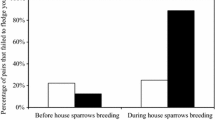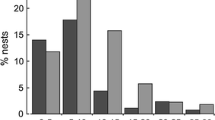Abstract
Using nest boxes with different sized entrances, we experimentally examined whether a large species of cavity breeder (House Sparrow, Passer domesticus) affects the nest box occupancy and breeding success of a smaller species (Great Tit, Parus major), and whether there are differences in the effects of competition during different parts of the breeding season. Great Tits occupied nest boxes regardless of the number of House Sparrows breeding in the vicinity. During the second part of the breeding season, the percentage of successful Great Tit pairs was negatively correlated with the occupation of nest boxes by the House Sparrows, in both the large- and small-entrance nest boxes. More Great Tit pairs bred and more young were fledged in the small- than large-entrance nest boxes. Great Tits occupied more large-entrance nest boxes during the first than the second part of the breeding season. This difference was probably due to House Sparrows occupying more large-entrance nest boxes during the second than first part of the breeding season. 74 % of the large-entrance nest boxes in which Great Tits built nests in both the first and second parts of the season were later occupied by House Sparrows. Great Tits preferred large-entrance nest boxes in the fall, when House Sparrows use only a few boxes for roosting, but not for breeding. The findings indicate that Great Tits are subject to interspecific competition with House Sparrows for nesting cavities, the intensity of which varies during the breeding season and is higher during the second part when more House Sparrows breed.
Zusammenfassung
Asymmetrische saisonale Nistplatzkonkurrenz zwischen Kohlmeise Parus major und Haussperling Passer domesticus
Mit Hilfe von Nistkästen mit unterschiedlich großen Öffnungen untersuchten wir experimentell, ob eine große höhlenbrütende Art (Haussperling, Passer domesticus) die Besetzung von Nistkästen durch eine kleinere höhlenbrütende Art (Kohlmeise, Parus major) und deren Bruterfolg beeinflusst und ob es Unterschiede in den Effekten der Konkurrenz zu verschiedenen Zeiten der Brutsaison gibt. Kohlmeisen besetzten Nistkästen unabhängig von der Zahl der in der Nähe brütenden Haussperlinge. Während des zweiten Teils der Brutsaison war der Anteil von erfolgreichen Kohlmeisen-Paaren negativ korreliert mit der Besetzung von Nistkästen durch den Haussperling, und zwar sowohl in Nistkästen mit großen als auch kleinen Eingangsöffnungen. In den Nistkästen mit kleinen Eingangsöffnungen brüteten mehr Kohlmeisenpaare und mehr Jungvögel wurden flügge als in den Kästen mit großer Eingangsöffnung. Kohlmeisen besetzten im ersten Teil der Brutsaison mehr Nistkästen mit großer Eingangsöffnung als im zweiten Teil. Dieser Unterschied kam wahrscheinlich dadurch zustande, dass Haussperlinge im zweiten Teil der Brutsaison mehr Nistkästen mit großer Eingangsöffnung besetzten als im ersten. 74 % der Nistkästen mit großer Eingangsöffnung, in denen Kohlmeisen sowohl im ersten als auch zweiten Teil der Brutsaison nisteten, wurden später von Haussperlingen besetzt. Kohlmeisen bevorzugten im Herbst Nistkästen mit großer Eingangsöffnung, wenn Haussperlinge nur wenige Kästen zum schlafen nutzen, aber nicht zum brüten. Die Ergebnisse deuten darauf hin, dass Kohlmeisen mit Haussperlingen in einer interspezifischen Konkurrenz um Bruthöhlen stehen, deren Intensität sich im Verlauf der Brutsaison ändert und im zweiten Teil größer ist, wenn mehr Haussperlinge brüten.




Similar content being viewed by others
References
Barba E, Gil-Delgado JA (1990) Competition for nest-boxes among four vertebrate species: an experimental study in orange groves. Ecography 13:183–186
Blair RB (1996) Land use and avian species diversity along an urban gradient. Ecol Appl 6:506–519
Blanc L, Walter JR (2008) Cavity nest-webs in a longleaf pine ecosystem. Condor 110:80–92
Blanc L, Walters JR (2007) Cavity-nesting community webs as predictive tools: where do we go from here? J Ornithol 148:417–423
Cam E, Nichols JD, Sauer JR, Hines JE, Flather CH (2000) Relative species richness and community completeness: birds and urbanization in the mid-Atlantic states. Ecol Appl 10:1196–1210
Chamberlain DE, Toms MP, Cleary-McHarg R, Banks AN (2007) House sparrow (Passer domesticus) habitat use in urbanized landscapes. J Ornithol 148:453–462
Charter M, Izhaki I, Leshem Y (2010a) Effects of the risk of competition and predation in large secondary cavity breeders. J Ornithol 151:791–795
Charter M, Leshem Y, Halevi S, Izhaki I (2010b) Nest box use by great tits in semi–arid rural residential gardens. Wilson J Ornithol 122:604–608
Charter M, Izhaki I, Leshem Y (2011) Predation or facilitation? An experimental assessment of whether generalist predators affect the breeding success of passerines. J Ornithol 153:533–539
Clergeau P, Jokimäki J, Savard J-PL (2001) Are urban bird communities influenced by the bird diversity of adjacent landscapes? J Appl Ecol 38:1122–1134
Crooks KR, Suarez AV, Bolger DT (2004) Avian assemblages along a gradient of urbanization in a highly fragmented landscape. Biol Conserv 115:451–462
Dhondt AA (1977) Interspecific competition between great and blue tit. Nature 268:521–523
Dhondt AA (1989) Ecological and evolutionary effects of interspecific competition in tits, Parus spp. Wilson Bull 101:198–216
Dhondt AA (2010) Effects of competition on great and blue tit reproduction: intensity and importance in relation to habitat quality. J Anim Ecol 79:257–265
Dhondt AA, Adriaensen F (1999) Experiments on competition between great and blue tit: effects on blue tit reproductive success and population processes. Ostrich 70:39–48
Dhondt AA, Eyckerman R (1980) Competition and the regulation of numbers in great and blue tits. Ardea 68:121–132
Forsman JT, Hjernquist MB, Taipale J, Gustafsson L (2008) Competitor density cues for habitat quality facilitating habitat selection and investment decisions. Behav Ecol 19:539–545
Germaine SS, Rosenstock SS, Schweinsburg RE, Richardson WS (1998) Relationships among breeding birds, habitat, and residential development in greater Tuscon, Arizona. Ecol Appl 8:680–691
Gustafsson L (1987) Interspecific competition lowers fitness in the collared flycatcher Ficedula albicollis: an experimental demonstration. J Anim Ecol 68:291–296
Gustafsson L (1988) Inter- and intraspecific competition for nest-entrances in a population of the collared flycatcher Ficedula albicollis. Ibis 130:11–15
Hakkarainen H, Korpimäki E (1996) Competitive and predatory interactions among raptors: an observational and experimental study. Ecology 77:1134–1142
Hedblom M, Söderström B (2012) Effects of urban matrix on reproductive performance of Great Tit (Parus major) in urban woodlands. Urban Ecosyst 15:167–180
Keddy PA (1989) Competition. Chapman and Hall, London
Kempenaers B, Dhondt AA (1991) Competition between blue and great Tit for roosting sites in winter: an aviary experiment. Ornis Scand 22:73–75
Loeb SC, Hooper RG (1997) An experimental test of interspecific competition for red-cockaded woodpecker cavities. J Wildl Manag 61:1268–1280
Löhrl H (1977) Nistökologische und ethologische Anpassungserscheinungen bei Höhlenbrütern. Vogelwarte 29:92–101
Marzluff JM (2001) Worldwide urbanization and its effects on birds. In: Marzluff JM et al (eds) Avian ecology and conservation in an urbanizing world. Kluwer, Dordrecht, pp 19–38
Maurer BA (1984) Interference and exploitation in bird communities. Wilson Bull 96:380–395
Menge BA, Sutherland JP (1976) Species diversity gradients: synthesis of the roles of predation, competition, and temporally heterogeneity. Am Nat 110:351–369
Merilä J, Wiggins DA (1995) Interspecific competition for nest holes causes adult mortality in the collared flycatcher. Condor 97:445–450
Miller JR, Hobbs RJ (2002) Conservation where people live and work. Conserv Biol 16:330–337
Minot EO (1981) Effects of interspecific competition for food in breeding blue and great tits. J Anim Ecol 50:375–385
Minot EO, Perrins CM (1986) Interspecific interference competition–nest sites for blue and great tits. J Anim Ecol 55:331–350
Nilsson SG (1984) The evolution of nest-site selection among hole-nesting birds: the importance of nest predation and competition. Ornis Scand 15:167–175
Reynaud PA, Thioulouse J (2000) Identification of birds as biological markers along a neotropical urban-rural gradient (Cayenne, French Guiana), using co-inertia analysis. J Environ Manag 59:121–140
Scheiner SM, Gurevitch J (2001) Design and analysis of ecological experiments, 2nd edn. Oxford University Press, New York
Schoener TW (1983) Field experiments on interspecific competition. Am Nat 102:240–285
Slagsvold T (1978) Competition between the great tit Parus major and the pied flycatcher Ficedula hypoleuca: an experiment. Ornis Scand 9:46–50
Strubbe D, Matthysen E (2009) Experimental evidence for nest-site competition between invasive ring-necked parakeets (Psittacula krameri) and native nuthatches (Sitta europaea). Biol Conserv 142:1588–1594
van Balen JH, van Booy CJH, van Franeker JA, Osieck ER (1982) Studies on hole-nesting birds in natural nest sites. Availability and occupation of natural nest sites. Ardea 70:1–24
Wiens JA (1989) The ecology of bird communities, vol 2; processes and variations. Cambridge University Press, Cambridge
Yavin S (1987) Nest site selection of the great tit (Parus major terrae-sanctae). MSc thesis, Tel Aviv University
Acknowledgments
We thank the residents of Moshav Ram-On for their assistance. Special thanks to Shai Halevi. Hava Ravid, Uri Ravid, and Daniel Berkowic for technical assistance in the field, to Arnon Lotem and Gadi Katzir for advice, to André Dhondt and Shai Markman for comments on the manuscript, and to Naomi Paz for editorial assistance.
Author information
Authors and Affiliations
Corresponding author
Additional information
Communicated by T. Friedl.
Rights and permissions
About this article
Cite this article
Charter, M., Leshem, Y. & Izhaki, I. Asymmetric seasonal nest site competition between Great Tits and House Sparrows. J Ornithol 154, 173–181 (2013). https://doi.org/10.1007/s10336-012-0884-5
Received:
Revised:
Accepted:
Published:
Issue Date:
DOI: https://doi.org/10.1007/s10336-012-0884-5




